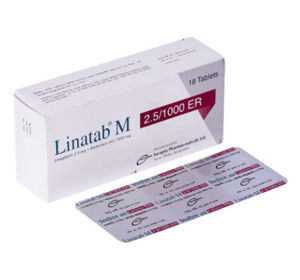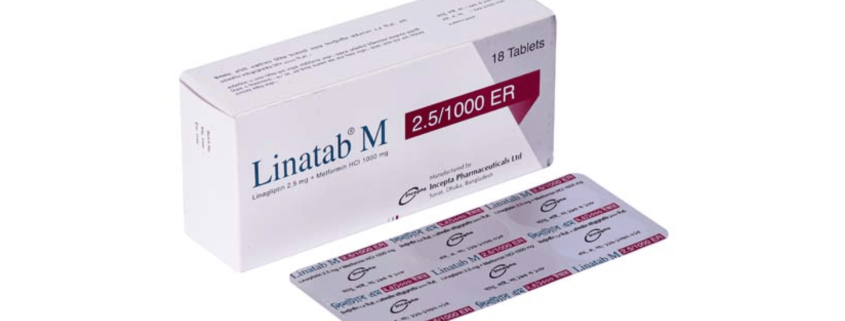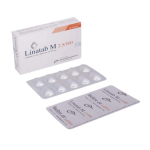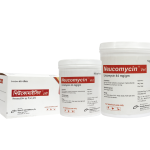Linatab M ER(Linagliptin + Metformin HCl)

Therapeutic Group: Anti Diabetic
Presentation
Linatab M 2.5/1000 ER: Each Extended Release tablet contains Linagliptin INN 2.5 mg and Metformin HCl BP 1000 mg.
Linatab M 5/1000 ER: Each Extended Release tablet contains Linagliptin INN 5 mg and Metformin HCl BP 1000 mg.
Description
LINATAB M ER is a combination of 2 oral antihyperglycemic drugs with complimentary mechanism of action to improve glycemic control in patients with type-2 diabetes mellitus: Linagliptin, a Dipeptidyl Peptidase-4 (DPP-4) inhibitor and Metformin, a member of the biguanide class. Linagliptin is a dipeptidyl peptidase-4 (DPP-4) inhibitor, which exerts its action by slowing the inactivation of incretin hormones. Incretin hormone levels are increased in response to a meal. When blood glucose concentrations are normal or elevated, incretin hormones increase insulin synthesis and release from pancreatic beta cells. incretin hormones also lowers glucagon secretion from pancreatic alpha cells, leading to reduced hepatic glucose production. Metformin decreases hepatic glucose production, decreases intestinal absorption of glucose, and increases peripheral glucose uptake and utilization.
Indications
Indication:
Combination of Linagliptin and Metformin extended release is indicated as an adjunct to diet and exercise to improve glycemic control in adults with type-2 diabetes mellitus when treatment with both Linagliptin and Metformin is appropriate.
Important Limitations of Use:
– Not for treatment of type 1 diabetes or diabetic ketoacidosis, as it would not be effective in these settings
– Has not been studied in patients with a history of pancreatitis
Dosage & Administration
• Individualize the starting dose of Linagliptin and Metformin extended release formulation based on the patients current regimen
• Do not exceed a total daily dose of Linagliptin 5 mg and Metformin 2000 mg
• Give once daily with a meal
• Swallow whole; do not split, crush, dissolve or chew
• Recommended starting dose:
– In patients currently not treated with Metformin, initiate treatment with 5 mg Linagliptin/1000 mg Metformin hydrochloride extended release once daily with a meal
– In patients already treated with Metformin, start with 5 mg of Linagliptin total daily dose and a similar total daily dose of Metformin once daily with a meal
– In patients already treated with Linagliptin and Metformin separately or combination of these two, switch to extended release formulation of this combination containing 5 mg of Linagliptin total daily dose and a similar total daily dose of Metformin once daily with a meal
Side Effects
Adverse reactions reported in 5% of patients treated with Linagliptin and Metformin coadministered and more commonly than in patients treated with placebo are nasopharyngitis and diarrhea
Precautions
• Lactic acidosis: Lactic acidosis can occur due to Metformin accumulation during treatment with Linagliptin & Metformin combination. If metformin-associated lactic acidosis is suspected, general supportive measures should be instituted promptly in a hospital setting, along with immediate discontinuation of Linagliptin and Metformin combination
• Renal impairment:
-Prior to initiation, asses renal function with estimated Glomerulan Filtration Rate (eGFR)
-Contraindicated in patients with eGFR below 30 mL/min/1.73 m2
-Initiation is not recommended in patients with eGFR between 30-45 mL/min/1.73 m2
-Asses risk/benefit of continuing if GFR falls below 45 mL/min/1.73 m2
-Obtain an eGFR at least annually in all patients taking Linagliptin and Metformin combination
-Discontinue if eGFR falls below 30 mL/min/1.73 m2
• Hepatic impairment and hypoxic states: It is not recommended in hepatic impairment or hypoxic states
• Radiologic studies with contrast: Linagliptin and Metformin combination may need to be discontinued at the time of, or prior to, an iodinated contrast imaging procedure in patients with an eGFR
between 30 and 60 mL/min/1.73 m2
• Pancreatitis: There have been postmarketing reports of acute pancreatitis, including fatal pancreatitis. If pancreatitis is suspected, promptly discontinue this drug
• Hypoglycemia: When used with an insulin secretagogue (e.g. sulfonylurea (SU) or insulin, consider lowering the dose of the insulin secretagogue or insulin to reduce the risk of hypoglycemia
• Vitamin B12 deficiency: Metformin may lower vitamin B12 levels. Monitor hematologic parameters annually
• Arthralgia: Severe and disabling arthralgia has been reported in patients taking DPP-4 inhibitors. Consider as a possible cause for severe joint pain and discontinue drug if appropriate
• Bullous pemphigoid: There have been postmarketing reports of Bullous pemphigoid requiring hospitalization in patients taking DPP-4 inhibitors. Tell patients to report development of blisters or
erosions. If Bullous pemphigoid is suspected, discontinue the drug
• Macrovascular outcomes: No conclusive evidence of macrovascular risk reduction with Linagliptin and Metformin combination
Use in Pregnancy & Lactation
Pregnancy: Pregnancy category B. The limited data with Linagliptin and Metformin combination and Linagliptin use in pregnant women are not sufficient to inform a Linagliptin and Metformin combination-associated or Linagliptin-associated risk for major birth defects and miscarriage. Published studies with metformin use during pregnancy have not reported a clear association with metformin and major birth defect or miscarriage risk.
Lactation: There is no information regarding the presence of Linagliptin or Metformin in human milk, the effects on the breastfed infant, or the effects on milk production. Therefore, the developmental and health benefits of breastfeeding should be considered along with the mother’s clinical need for this drug and any potential adverse effects on the breastfed child from Linagliptin and Metformin combination.
Drug Interaction
– Carbonic Anhydrase Inhibitors may increase risk of lactic acidosis. Consider more frequent monitoring
– Strong P-glycoprotein/CYP3A4 inducer: Efficacy may be reduced when administered in combination (e.g., Rifampin). Use of alternative treatments is strongly recommended
– Alcohol may potentiate the effect of Metformin on lactate metabolism. Warn patient against excessive alcohol intake
– Drugs that reduce Metformin clearance (such as Ranolazine, Vandetanib, Dolutegravir and Cimetidine) may increase the accumulation of Metformin. Consider the benefits and risks of concomitant use
Over Dose
In the event of an overdose with Linagliptin + Metformin combination, contact the Poison Control Center. Employ the usual supportive measures (e.g., remove unabsorbed material from the gastrointestinal tract, employ clinical monitoring, and institute supportive treatment) as dictated by the patient’s clinical status. Removal of Linagliptin by hemodialysis or peritoneal dialysis is unlikely. However, Metformin is dialyzable with a clearance of up to 170 mL/min under good hemodynamic conditions. Therefore, hemodialysis may be useful partly for removal of accumulated Metformin from patients in whom Linagliptin + Metformin combination overdosage is suspected.
Linagliptin: During controlled clinical trials in healthy subjects, with single doses of up to 600 mg of Linagliptin (equivalent to 120 times the recommended daily dose), there were no dose-related clinical adverse drug reactions. There is no experience with doses above 600 mg in humans.
Metformin: Overdose of Metformin has occurred, including ingestion of amounts greater than 50 grams. Hypoglycemia was reported in approximately 10% of cases, but no causal association with Metformin has been established. Lactic acidosis has been reported in approximately 32% of Metformin overdose cases.
Storage
Store at 25°C. Protect from exposure to high humidity. Store in a safe place out of reach of children.
Commercial Pack
Linatab M 2.5/1000 ER: Each box contains 3 blister strips of 6 tablets.
Linatab M 5/1000 ER: Each box contains 3 blister strips of 6 tablets



